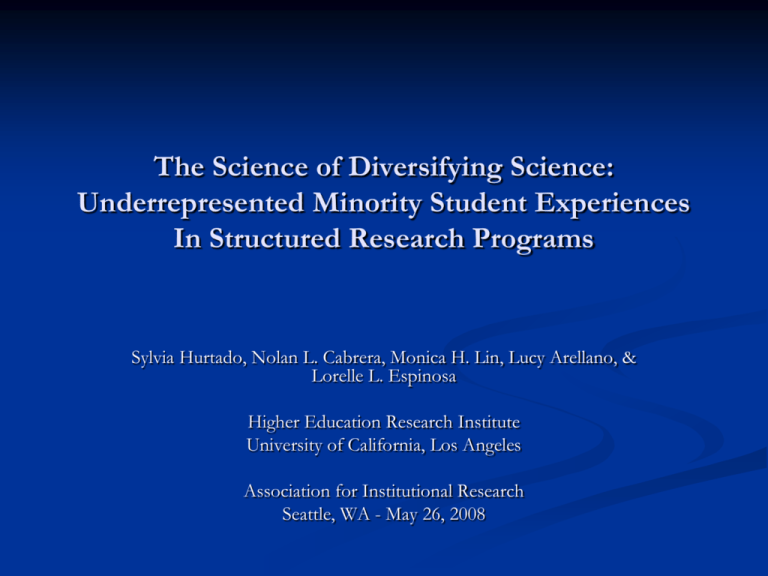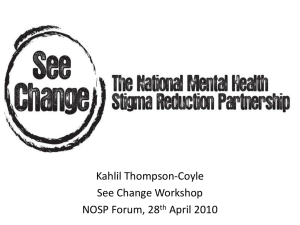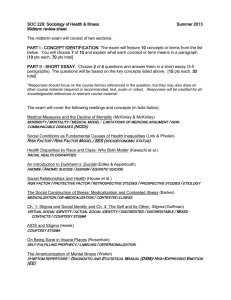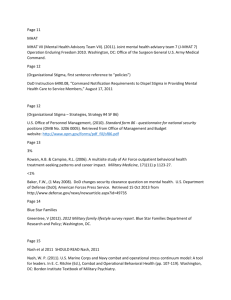The Science of Diversifying Science: Underrepresented Minority
advertisement

The Science of Diversifying Science: Underrepresented Minority Student Experiences In Structured Research Programs Sylvia Hurtado, Nolan L. Cabrera, Monica H. Lin, Lucy Arellano, & Lorelle L. Espinosa Higher Education Research Institute University of California, Los Angeles Association for Institutional Research Seattle, WA - May 26, 2008 Background Demographic shift: Increasing number of underrepresented minority (URM) students entering college National call for increased number of research scientists - Rising Above the Gathering Storm (2005); America Competes Act (2007) Next report on diversification of the scientific workforce - coming year New focus on undergraduate scientific training Issues & Challenges Attrition rates of URM students majoring BBS Comparable rates of BBS major intention relative to White students (44%) 27% of intended URM majors complete; White students 46% End of pipeline: URMs are 7% of BBS PhDs Programmatic initiatives - especially NIH URM-specific retention & academic achievement; more than 30 years of investment of NIH Benefits of undergraduate research experiences Increased graduate school enrollment Purpose Examine URM experiences in undergraduate research programs for insight into: Challenges & benefits How students experience science Increase the research on the efficacy of interventions like undergraduate research programs Theoretical Framework Self-Efficacy (Bandura, 1997) External expectations (social) Internal beliefs about the self (individual) Development of science self-efficacy Paradigms (Kuhn, 1970) Current theories/methods consistently limited Paradigm shift; working on the border of the norms of science (i.e., how science is done; who can do science) The culture of science: competitive, hierarchical Data & Sample Semi-structured, focus group interviews 4 Campuses: MIT, Xavier (Louisiana), University of New Mexico, & UT San Antonio 65 student participants, purposefully recruited 62% female/38% male 60% Latina/o, 22% Black, 5% Asian American, 8% multiracial, 3% American Indian, & 3% White 72% were biology, biochemistry, or chemistry majors Analysis Phenomenological inquiry (Creswell, 2003) Inter-coder reliability (Miles & Huberman, 1994) Coding organized using NVivo (Bazely, 2007) Triangulation (Creswell, 2003) Findings Becoming A Scientist Navigating the Culture of Science Pre-college aspirations Research exposure Research career goals Scientific self-efficacy through research Collaborative Competitive Academic Intimidation Social Stigma Racial stigma and research opportunities Racial stigma and scientific self-efficacy Science stigma Findings: Becoming a Scientist Pre-college aspirations I was just always interested in how things worked and I always… I guess I dreamed of getting to a point where I didn’t have to ask people how things worked…so I wanted to get the tools to be able to figure that stuff out on my own… (MIT female) Research exposure In the teaching lab…I mean, you run an experiment and it always works. It’s so nice. It always works. You take biochem lab, you take genetics lab, and you do it, and man, it’s going to work. It’s been done 50,000 times in the lab… People who have never been in a research lab, I think the first time your experiment fails, it’s kind of like a shock to everyone. It’s kind of like, “What?” Yeah, it makes you learn how to think… (UTSA female) Findings: Becoming a Scientist (cont.) Research career goals I initially wanted to go into medicine just for the whole helping people thing, and then I got accepted into the IMSD program and had the opportunity to do research and found that I actually liked that better than I think I would doing medicine, so that’s…why I chose to stick with research. (UNM male) Scientific self-efficacy through research I learned how to fail this summer. I’m not used to failing… As a scientist, you have to learn that sometimes things just don’t work. You have to pick up your boots and keep on truckin’. (Xavier female) Findings: Becoming a Scientist (cont.) Scientific self-efficacy through research I had a good experience with my PIs [principal investigators] just because they made me feel like…as an undergrad, you kind of feel like on the bottom of the food chain and they kind of believe in you and say, “Yes, you can do this. I’m giving you this project to do and I know you can do it.” So it kind of builds your confidence and just them believing in you makes you feel like you can actually complete the project because you can. (UNM female) Findings: Culture of Science Collaborative It seems like at Xavier, the people have a mentality…like the sharing mentality, so if you’re not…if you don’t share or if you’re not…if you’re thinking about number one, they kind of shun you to the side. I mean, because everyone else is in the group and [if] you think you can work better on your own, we’ll let you work on your own. That’s how it is here. (Xavier female) Competitive …you start getting to know everyone in the department or in the classes that you’re taking, so you’re almost embarrassed to do poorly in class, so you work harder. Like you’re driven to work harder because you want to be a good student and you want to succeed. (UNM female) Findings: Culture of Science (cont). Academic Intimidation People in organic chemistry don’t sit there and ask, ‘How did that work?’ You wait until office hours, in the quiet, and make sure nobody thinks that you’re dumb. (MIT female) Findings: Social Stigma Racial stigma and research opportunities I worked with an Anglo girl who was there and basically paid her way there and the only reason she was there is because she knew someone who knew someone, and I told her, “Oh, I’m in this…minority summer research program,” and she’s like, “Yeah, well, you’re lucky you’re a minority, you could say that on a piece of paper so you could get in.” (UNM female) Racial stigma and scientific self-efficacy [B]ecause I am a minority student, I feel as if I need the validation. Anybody else would not need it. You know, nobody else has this feeling of, “You know what? My opinions aren’t going to be listened to…unless I get the PhD.” (MIT male) Findings: Social Stigma (cont.) Science stigma [T]hey label us “geeks,” right, but yet they turn…around and they like electrical engineering, they like their cell phones and they love their iPods, they love their X-boxes, they couldn’t live without them, and their plasma screens… But then they turn around…and they say, “Hey, you geek…” So my friends there, that I used to have back in the barrio, they don’t talk to me anymore, “Oh, you think you’re too good…” I lost all my friends… (UTSA male) Discussion Science experienced as collaborative/ competitive; intimidating and disempowering exciting and as well as empowering High degree of self-efficacy; function of student sample Target programs viewed as “unearned” privilege - stigma of URM having to prove oneself Implications for Practice Help students experience the collaborative and empowering side of science Identify predisposition for science, not simply lack of preparation to inform persistence New paradigm: inclusive excellence; reduce URM stigma (attitude change) This study was made possible by the support of the National Institute of General Medical Sciences, NIH Grant Number 1 RO1 GMO71968-01. This independent research and the views expressed here do not indicate endorsement by the sponsor. For more information on the project and copies of the paper: http://www.gseis.ucla.edu/heri/nih







